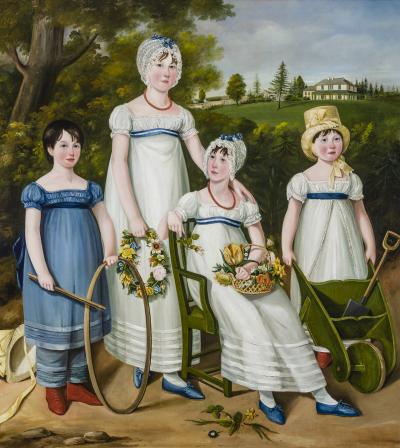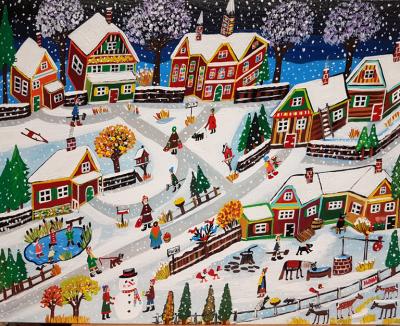We the People: American Folk Portraits
American folk portraits are treasured for many reasons, foremost, their aesthetic appeal. The rhythms, lines, shapes, and color combinations in these likenesses draw attention and provoke an emotional response. Most folk painters were self-taught, and their desire to follow academic principles or adopt prevailing artistic conventions varied greatly.
In the decades following the American Revolution, wealthy and powerful patrons sought out academically oriented artists, while folk painters responded to the growing needs of a burgeoning middle class. Their painted likenesses served many purposes, but today are most helpful in the information they reveal about how ordinary people lived, what they valued, and how they wished to be remembered.
The exhibition We the People: American Folk Portraits, at Colonial Williamsburg’s Abby Aldrich Rockefeller Folk Art Museum in Williamsburg, Virginia, opened May 2017 as part of AARFAM’s sixtieth anniversary celebrations; it remains on view through December 2020.1 Abby Aldrich Rockefeller devoted nearly ten years to assembling her collection of American folk art, before giving the majority of her private collection to Colonial Williamsburg in 1939. Ms. Rockefeller appreciated the aesthetic relationships between American folk and modern art and advocated for the study and admiration of both. According to family members, it was Rockefeller’s interest in American folk portraiture in particular that gave her the most pleasure.2
| Child with Hoop Artist unknown, America, ca. 1850 Oil on canvas, 43 x 34⅛ in. Gift of Abby Aldrich Rockefeller (1936.100.2) Chances are the child shown here is a boy rather than a girl. During the middle years of the nineteenth century, very young boys and girls wore similar attire and hairstyles. In this case, the diagonally placed rows of skirt trim and jacket buttons evoke a military look that was generally deemed more appropriate for boys. In the background, hints of an archway and the corner of a building, which show through on the left and right, respectively, are parts of an early version of the picture, later painted out by the artist. X-ray analysis also suggests that the artist struggled with the placement of the figure, ornamentation, and costume design. |  |
 | Child in Yellow Dress with Grey Cat Artist unknown, America, ca. 1835 Oil on canvas, 33⅝ x 29¼ in. Gift of Abby Aldrich Rockefeller (1936.100.12) At the time Abby Aldrich Rockefeller acquired this painting in 1936, its title was Child in Yellow Dress with Grey Cat. Within a few years, however, museum paperwork documented the portrait as that of Lydia and Tabitha. This later and personalized title appears in the museum’s first comprehensive catalogue, published in 1957, suggesting that Rockefeller may have been the one to give this portrait its endearing name. The title has recently been returned to its pre-acquisition identifier, in keeping with its earlier history. |
 | Mrs. Seth Wilkinson Attributed to Lyman Parks, eastern New York State, 1827–1830 Oil on tulip poplar panel, 39¼ x 33¼ in. Museum purchase (1960.100.2) In 2011, twenty oil-on-panel portraits were attributed to the artist who depicted Mrs. Seth Wilkinson. Because her likeness was among the first of this group to be studied and possibly remains the best known, her name became associated with the artist. New research has revealed the identity of the Wilkinson Limner as Lyman Parks, a painter also proficient in the medium of watercolor. For information, see “Mr. Willson of NH” and His Remarkable Watercolors by Deborah Child in the Autumn 2017 issue of this magazine. |
 |
| Two Children Artist unknown, America, ca. 1810. Oil on white pine panel, 22½ x 25⅝ in. From the collection of Abby Aldrich Rockefeller; Gift of the Museum of Modern Art (1954.100.2) This portrait is unusual in several respects, including the placement of the two subjects in the right half of a pronounced compositional triangle. The dramatic design focuses attention on the two youngsters, as does the contrast between their pale skin and dresses and the dominant browns and greens of the setting. The darkened room, open door, and temporarily placed bench or chair, create an air of mystery, suggesting that the children yearn to go outside—but cannot. The device of one child holding another clearly conveys sibling affection. |
 | Ammi Phillips (1788–1865) Polsapianna Bull Dorr (Mrs. Russell Dorr) and Maria Esther Dorr, Columbia County, N.Y., 1814–1815 Oil on canvas, 41⅝ x 33¾ in. Museum purchase (1958.100.15) In some cases, scarcity of time and money prompted some folk portraitists to render fashionable but very basic costume silhouettes repetitively, adding enough detail to persuade clients that they were getting individualized treatment. In this instance, the infant’s dress and the sheer white kerchief worn by Polsapianna Dorr have just enough detailing to offset the plainness of the mother’s costume and the background of the composition. |
| Jane A. Fort Van Rensselaer (Mrs. Henry Peter Van Rensselaer) Artist unknown, Claverack, N.Y., 1820–1825 Oil on canvas, 34½ x 28⅜ x 2¾ in. Museum purchase (1958.100.36) One erroneous assumption often made about folk portraiture is that the subjects are displeased because they appear not to be smiling. To the contrary, the vast majority of nineteenth-century subjects wished to be shown with pleasant facial expressions, and artists gladly accommodated them. The misinterpretation comes from the absence of broad grins exposing the subjects’ teeth, a norm today. Such an extreme expression was associated with an unbecoming lack of self-control during the period. Portraitists and their sitters instead strove for an agreeable countenance that was fit for posterity. To some viewers, Jane Van Rensselaer might appear to have a scowl on her face, but more than likely, her facial features are simply depicted in their natural resting position. |  |
 | Anna Webster Worthington Bull (Mrs. Isaac Bull) and Her Daughter, Rebecca Reed Bull Artist unknown, Kent County, Md., 1827 Oil on tulip poplar panel, 30¼ x 24⅜ in. Museum purchase (1964.100.6) Probably the most common misconception about folk painting is that itinerant artists carted canvases of pre-painted bodies around the countryside, filling in the heads from life later. While artists may have sketched in overall compositions to start, they worked up heads thoroughly before turning to the detailed development of other parts. Heads were considered the most critical aspects of portraits and their satisfactory proportions, placements, and renderings drove all other decisions related to the finished images. This composition of Anna Bull and her daughter is an affectionate statement of maternal love and childhood innocence. |
| William Anderson Roberts (1837–1899/1900) The Russell Girls with Cat, Yanceyville, N.C., ca. 1866 Oil on canvas, 45½ x 39¾ in. Museum purchase, Mr. and Mrs. Thomas Lee Caviness Jr. (2014.100.2) A prolific artist, William Anderson Roberts rendered likenesses in North Carolina, Virginia, and Kentucky. He began painting around the age of twenty. His surviving appointment books indicate roughly 106 portraits were completed in Caswell County, North Carolina, his home. Roberts enlisted in the Confederate Army early in the Civil War, although his actual time in combat was limited. Afterwards, he resumed his artistic activity, and it was during this time that he completed the portrait of sisters Annie “Fannie” Elizabeth and Sarah Bell Russell. |  |
| John James Trumbull Arnold (1812–1865) Portrait of Mary Mattingly, Mount Savage, Md., 1850 Oil on canvas, 38 x 31½ in. Museum purchase, the Friends of Colonial Williamsburg Collections Fund (2014.100.1). In mid-October 1850, itinerant painter John James Trumbull Arnold captured the likenesses of three Mattingly family members. One was this portrait of Mary, the young daughter of Ellen and Sylvester Mattingly of Mount Savage, Maryland. The artist inscribed the back of the portrait with the subject’s name and date. The painter also used the same ornate script on his pen-and-ink self-portrait, in the Colonial Williamsburg collection. In the inscription, he described himself as a “professor of penmanship,” an occupation that may have predisposed him to a heavy reliance on linear definition of hands and facial features. |  |
 |
| Jefferson Gauntt (1805–1864) Portrait of the Jennison Children, Brooklyn, N.Y. 1836 Oil on canvas, 63 x 68¾ in. Gift of John Newsome Jr. (2016-118) The striking unity of this large and complex family portrait speaks to the talent of Jefferson Gauntt, an artist with academic aspirations. Despite his formal training, Gauntt’s composition exhibits a slight awkwardness in execution, but that does not diminish the warmth and appeal of the Jennison children and their pet birds. The subjects were the eight offspring of Marie Antoinette and of William Jennison, a prosperous merchant who took his family from Baton Rouge, Louisiana, to Brooklyn, New York, by 1832. |
| Jacob Frymire (ca. 1770–1822) Portrait of Daniel Clarke, Penn., 1791 Oil on canvas, 31 x 26 in. Gift of Julie Lindberg in memory of Carl Michael Lindberg, College of William & Mary, Class of 1962 (2016.100.2) Many historical portraits show male subjects posed with one hand thrust through the opening of their coats or waistcoats. Modern-day viewers often interpret this as a way for artists to avoid painting hands, or assume that the subject’s hand must have been cold! But the reason is rooted in society’s perceptions of what make human bodies appear graceful. In the eighteenth and nineteenth centuries, men and boys were urged to assume their hand-in-the-waistcoat pose for many aspects of day-to-day deportment, even the simple act of sitting. Jacob Frymire’s portrait of Daniel Clarke portrays the youth in a sophisticated and fashionable pose. |  |
We the People observes this prolific form of American portraiture through some three dozen canvases created by both well-known and unidentified artists working from the decades immediately following the American Revolution through the Civil War. The exhibition features visitor favorites alongside new acquisitions never before seen by the public. It also addresses common misconceptions in the study of folk portraiture, dispelling age-old myths such as the idea that itinerant artists pre-painted the bodies of their sitters or that artists avoided painting a male subject’s hand by placing it in his waistcoat. The exhibition, which gives us a glimpse into the lives of the men, women, and children who helped to shape this country, is on view at the Art Museums of Colonial Williamsburg through December 2020. For more information, visit www.colonialwilliamsburg.com.
Laura Pass Barry is the Juli Grainger Curator of Paintings, Drawings, and Sculpture at the Colonial Williamsburg Foundation, Williamsburg, Virginia.
This article was originally published in the 18th Anniversary issue of Antiques & Fine Art magazine, a fully digitized copy of which is available at www.afamag.com. AFA is affiliated with Incollect.
2. The Rockefellers’ son Winthrop felt that, of all his mother’s collecting interests, her love of and appreciation for American folk art was probably the greatest. He remarked that well after her collection was given to the Foundation, she “loved to spend time with the Collection and to give private names to some of the naïve, yet charming, portraits that appealed especially to her.” See American Folk Art from the Abby Aldrich Rockefeller Folk Art Collection (Williamsburg, Va.: Colonial Williamsburg Foundation, 1959), pp. 5–6.































